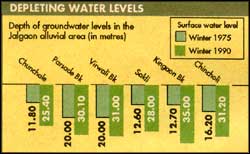Need for topping up underground water
 BANANAS are thirsty plants, and farmers in the Jalgaon area of Maharashtra -- who produce 10,00,000 tonnes of the state"s annual banana output of 17,00,000 tonnes -- have literally begun mining for water.
BANANAS are thirsty plants, and farmers in the Jalgaon area of Maharashtra -- who produce 10,00,000 tonnes of the state"s annual banana output of 17,00,000 tonnes -- have literally begun mining for water.
Groundwater levels in the area have fallen from 22 m in 1970 to 60 m. Baliram Borawale, a partner in Mohan Dhana and Co, a banana-trading firm, says, "Farmers draw water using electric motors, which accounts for the drop. The problem becomes acute in summer."
Senior geologist S K Gupta of the Groundwater Survey and Development Agency agrees with this and says, "In the areas of Raver, Yawal and Chopda, water extraction is very high and we have declared this a `dark watershed" area, which means that further exploitation of groundwater should be stopped. But nothing is being done. Farmers are digging wells at their own cost. There should be legislation to control well-digging at random."
In addition, he says, the minimum recommended distance of 152 m between wells is ignored. The situation in the area is exacerbated by cultivation of sugarcane, another thirsty crop.
Gupta says a scheme to top up groundwater by, for example, tapping a nearby river, is urgently needed. Zila parishad president R Patil says Jalgaon has been given an additional Rs 2 crore to finance such artificial recharging projects.
Surveys showed dug wells in the alluvial areas of Jalgaon were deepened every year by about 2.5 m. The geologists experimented and artificially recharged sands up to 20 m below the surface that were not being replenished by rainwater. They reported that if streams and nallas are kept wet artificially before the monsoon, irrigation wells would function better. "This experimental method executed on a large scale in the non-monsoon period is bound to benefit many dug wells in Jalgaon district."
More efficient irrigation would help. Suresh Jain, president of Jalgaon municipality, says farmers have stuck to traditional watering methods and points out that drip irrigation could cut water use by 30-35 per cent as well as increase yields by about 7 per cent. But, Borawale points out installation of a drip system is costly affair.
Concern about falling water levels in the upper Tapi basin of Jalgaon was so great the Nashik regional deputy director of the GSDA, B G Dhokarikar, and two geologists warned, "If the mining of water is not checked, banana plantation could well be endangered."
BANANA CULTIVATION IN JALGAON | ||
Hectares | Tonnes | |
| 1987-88 1988-89 1989-90 1990-91 1991-92 | 22,200 | 47 |
